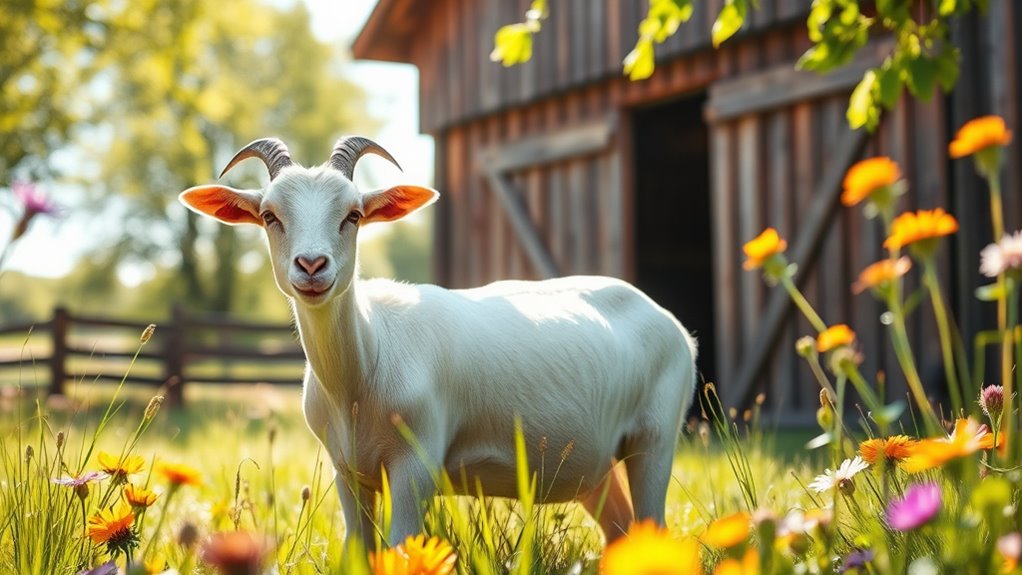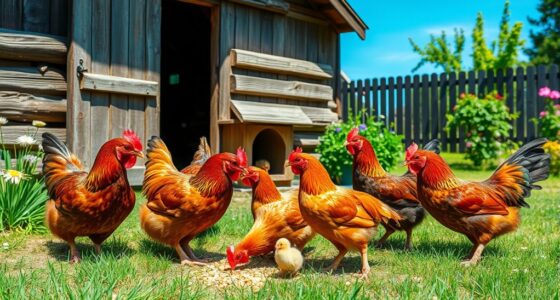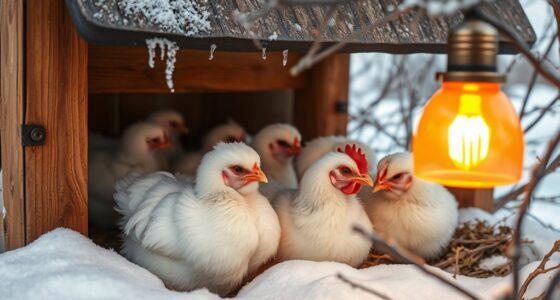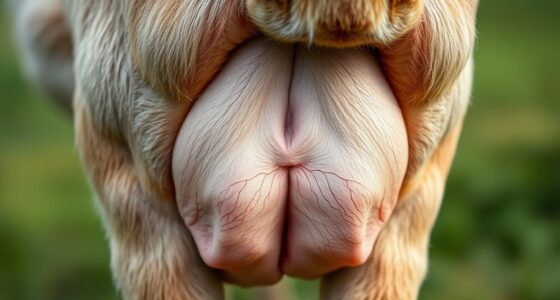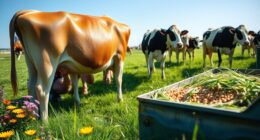If you suspect your goat is pregnant, look for signs like bagging udders, increased appetite, and behavioral changes. During pre-breeding, ensure your doe is healthy, vaccinated, and has a clean living space. As the pregnancy progresses, monitor her weight, introduce grain, and watch for signs of labor, like restlessness and nesting. After kidding, provide post-care for both doe and kids to ensure their health. Discover more essential tips for a successful kidding season ahead.
Key Takeaways
- Look for physical signs of pregnancy, such as bagging udders, increased appetite, and visible belly growth in goats.
- Provide pre-breeding care, including proper weight management, vaccinations, and parasite control for optimal health.
- Monitor for signs of impending labor like restlessness, nesting behavior, and swelling of the vulva as the due date nears.
- Prepare a clean and safe kidding area with essential supplies like towels, iodine, and gloves for post-kidding care.
- Ensure proper nutrition and veterinary care throughout pregnancy to support both the doe and her kids' health.
Signs of Pregnancy in Goats
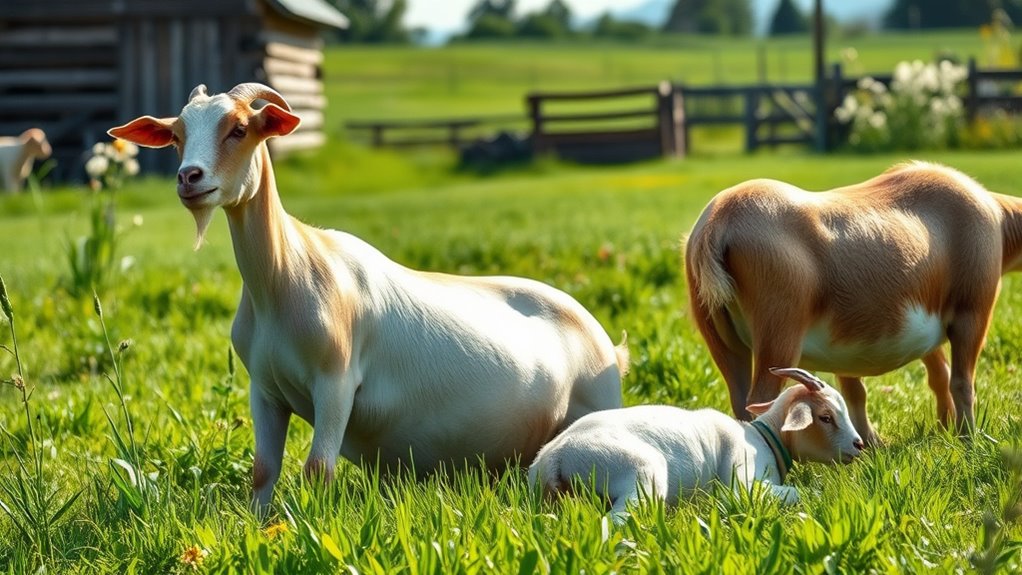
How can you tell if your goat is pregnant? Look for physical signs like bagging udders, especially in first-time does, and an increased appetite as their nutritional needs rise.
You might notice reduced milk production if she's being milked, along with visible belly growth or discreet carrying, depending on the doe. In later stages, you may even feel the kids moving.
Behaviorally, don't be surprised if she becomes less active, shows changes in social interaction, or starts nesting. Restlessness and an altered gait are common as labor approaches.
Watch for behavioral changes in your goat, such as reduced activity, altered social interactions, and nesting behavior as she nears labor.
Pay attention to these signs; they'll help you determine if your goat is expecting and ready for the next steps in her pregnancy journey.
Importance of Pre-Breeding Care
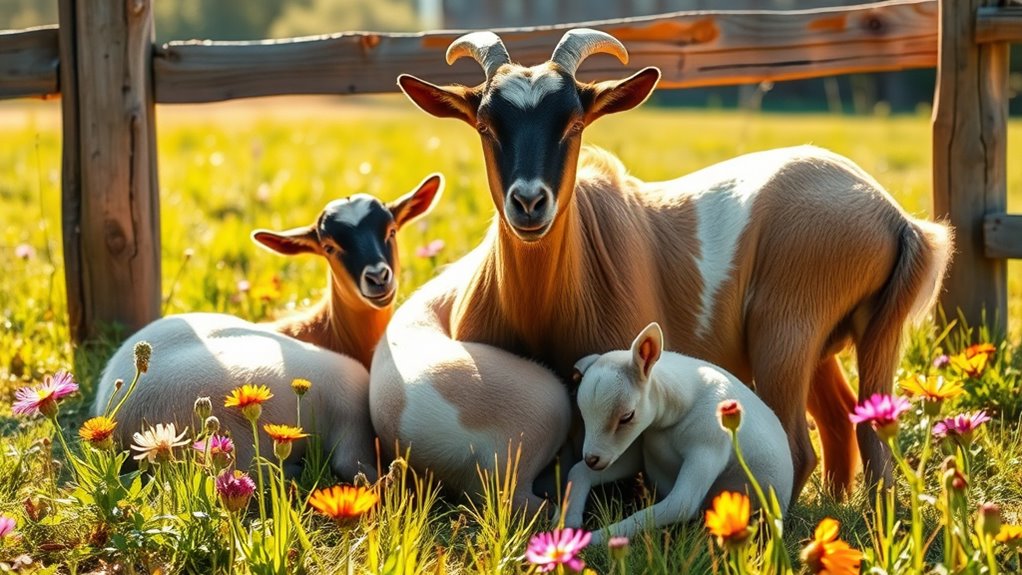
Understanding the signs of pregnancy in goats is only part of the equation; preparing them for breeding is just as important. Start by ensuring your does are at a healthy weight to avoid complications.
Provide adequate shelter from extreme weather and keep vaccinations up-to-date to prevent disease. Don't forget parasite control—deworm and treat for lice or mange beforehand. Regular hoof trimming is essential to prevent lameness.
Nutritionally, feed high-quality hay and introduce trace mineral supplements, while avoiding overfeeding. Make sure they've access to clean water.
Conduct health checks like CAE testing and monitor dental health. Lastly, reduce stress and maintain clean, well-ventilated living conditions to set your does up for a successful pregnancy.
Pregnancy Care Timeline
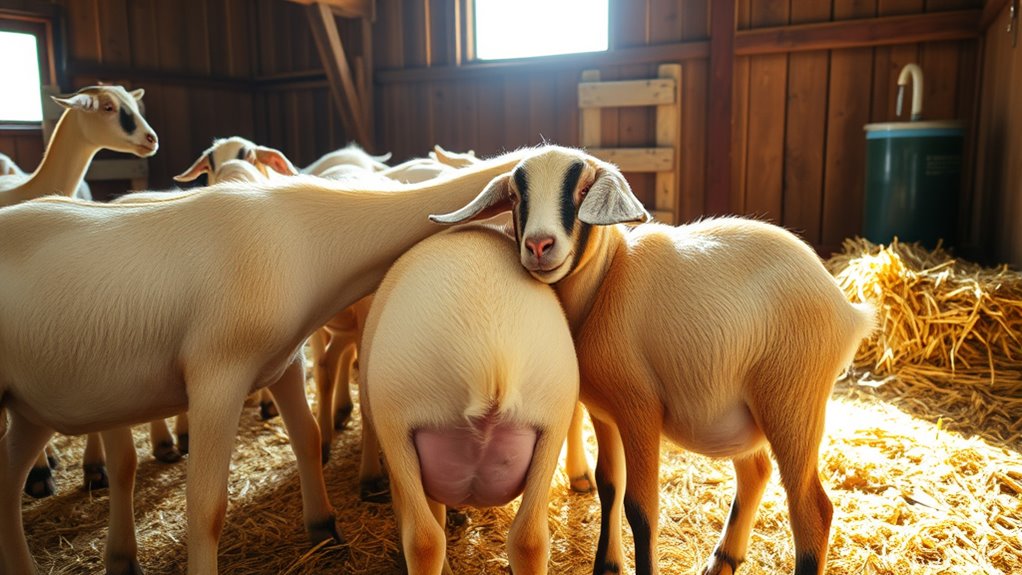
As your goat progresses through pregnancy, keeping track of her care timeline is essential for her health and the health of her kids.
Start by minimizing stress during the first few weeks post-breeding, focusing on high-quality hay and minerals.
As she enters early to mid-pregnancy, expect an increase in appetite and monitor her weight to maintain optimal body condition.
In mid-pregnancy, gradually introduce grain and schedule vaccinations a month before kidding.
During late pregnancy, increase nutritional support and check for ketones in her urine.
Prepare her kidding stall and stock a kidding kit, ensuring you're ready for any complications.
Maintaining a stable environment and monitoring her health throughout will help ensure a smooth delivery.
Recognizing Signs of Impending Labor
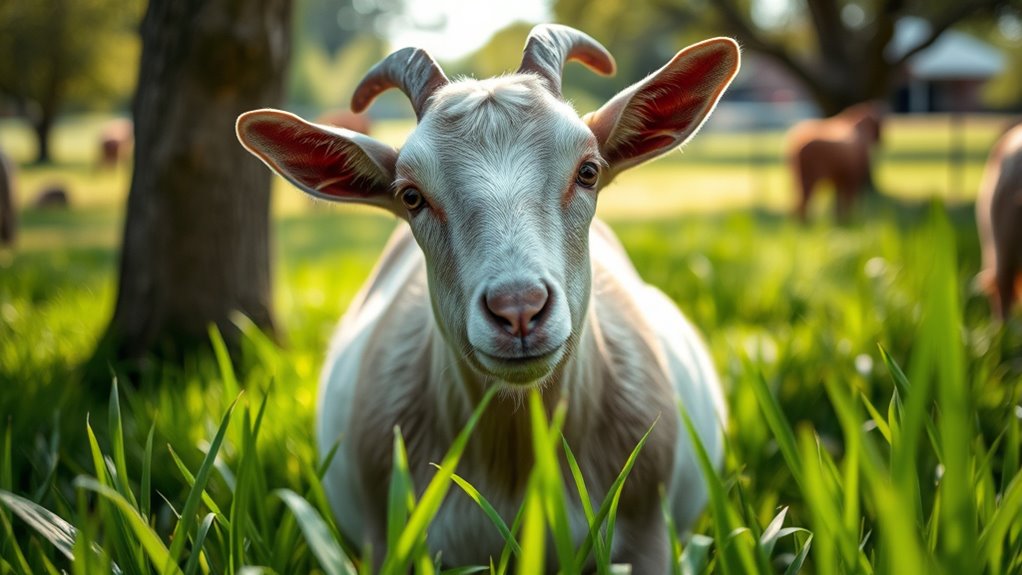
Recognizing the signs of impending labor in pregnant goats is crucial for ensuring a safe delivery.
Watch for nesting behavior; your goat may paw at the ground or gather bedding. Restlessness and discomfort often signal that labor is near, and you might notice a white discharge or mucus plug.
Loose ligaments around the tail indicate preparation for birth, while physical changes like a "hollowed out" appearance can show the kid moving into position.
Swelling of the vulva, udder formation, and unusual tail positions are also key signs.
If she stops eating, withdraws socially, or vocalizes more than usual, it's time to monitor her closely.
Stay alert for these signs to ensure everything goes smoothly.
Preparing for Kidding
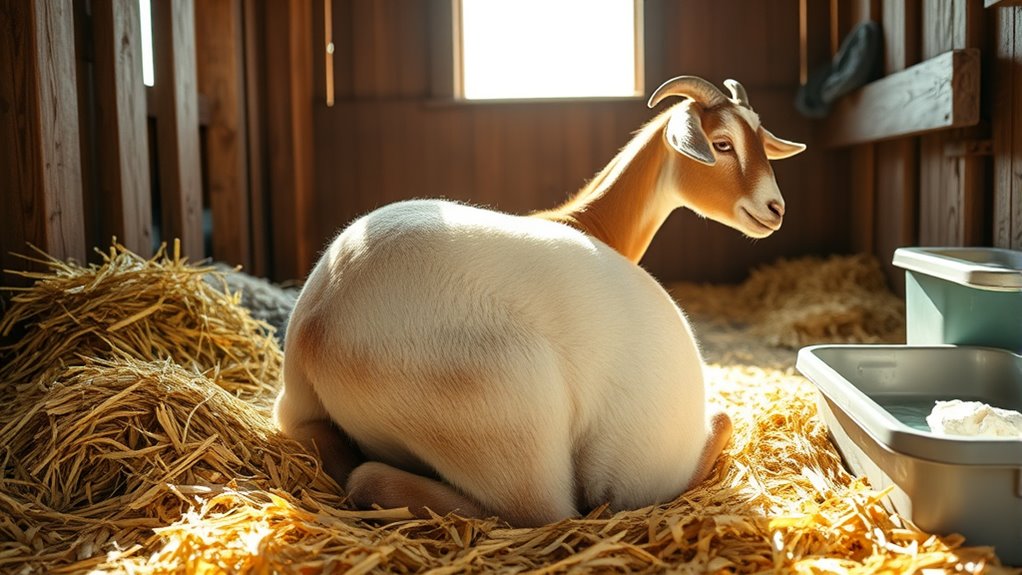
Once you've identified the signs of impending labor in your pregnant goats, it's time to prepare for kidding.
Start by cleaning and disinfecting the barn and all equipment to minimize infection risks. Set up individual kidding pens to provide a safe space for each doe, and secure heat lamps to keep the newborn kids warm. Use clean straw as bedding to avoid inhalation issues.
Make sure your does are in good health by administering the CD&T vaccine and checking for parasites. Provide high-quality feed and mineral supplements to support fetal development.
Lastly, ensure a stress-free environment and monitor your does closely. Familiarize yourself with normal labor signs, and keep your veterinarian's contact information handy for emergencies.
Essential Supplies for Kidding
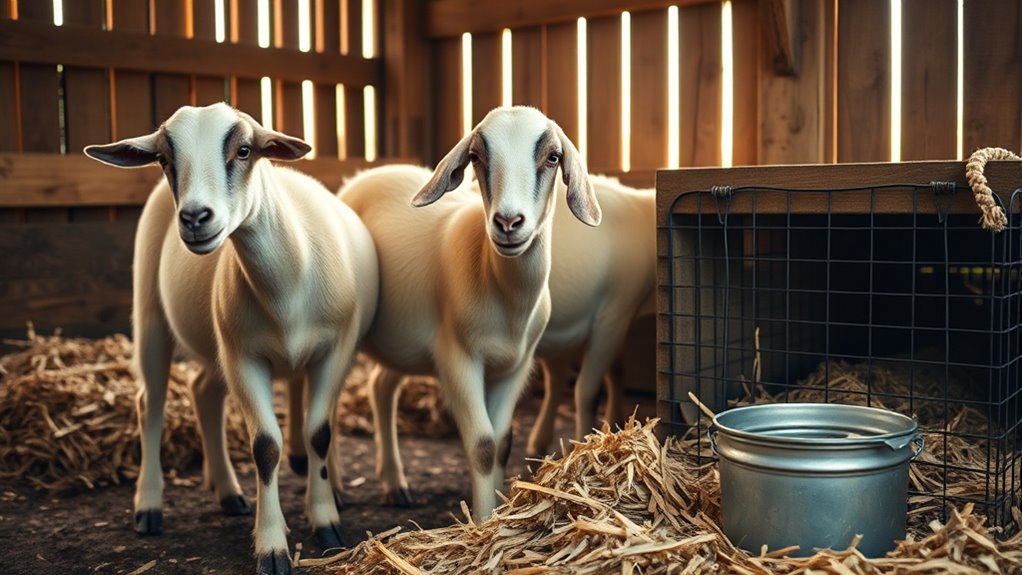
When preparing for kidding, having the right supplies on hand is crucial for ensuring the health and safety of both the newborn kids and their mothers.
You'll need several towels for drying the kids, especially if it's cold. Puppy pads help keep the area clean and provide a dry surface. Disposable gloves are essential for handling the kids and performing inspections, while lubricant can assist with kid positioning.
Don't forget 7% iodine to dip the umbilical cords and prevent infections. A digital thermometer lets you monitor temperatures, and a nasal aspirator clears airways.
Keep emergency numbers handy, along with vaccinations, medications, and a bulb syringe for any urgent needs. Being prepared makes all the difference!
Post-Kidding Care for the Doe

After ensuring you have all supplies ready for kidding, it's time to focus on the care your doe needs post-kidding.
First, provide warm water with molasses or electrolytes to boost her energy and hydration. Gradually introduce grains to support her milk production and ensure she's access to high-quality hay for a balanced diet.
Monitor her udder for signs of mastitis, and keep an eye on the afterbirth to ensure it detaches naturally. Maintain a clean environment and offer free-choice minerals, especially calcium, to support her overall health.
Allow her time to rest and recover, providing energy-boosting warm molasses water as needed. Lastly, ensure she stays hydrated to support lactation effectively.
Ensuring Healthy Kids After Birth
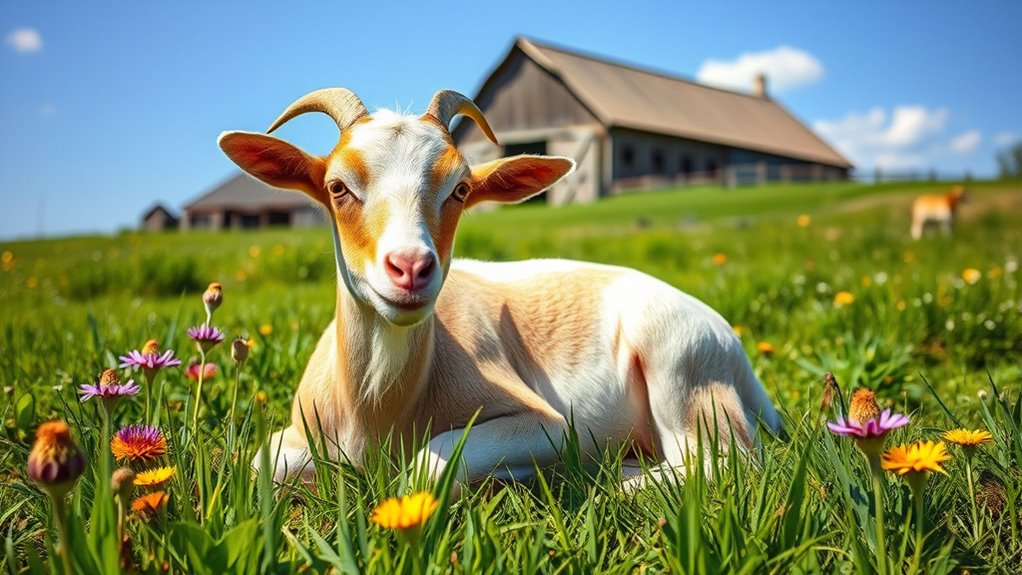
To ensure your newborn kids thrive, it's crucial to address their immediate needs right after birth. Start by clearing their nasal passages and mouths of mucus to support proper breathing.
Within two hours, provide colostrum to ensure they receive vital immunity. Don't forget to dip their navel cords in iodine to prevent infection.
Maintain a clean, dry environment to protect against hypothermia. Assess their vigor; if any appear lifeless, act quickly.
Feed colostrum at 10% of their body weight within the first 24 hours. If necessary, use high-quality milk replacers and establish a feeding schedule to prevent health issues.
Monitor for signs of disease and maintain hygiene to keep your kids healthy as they grow.
Common Challenges During Pregnancy
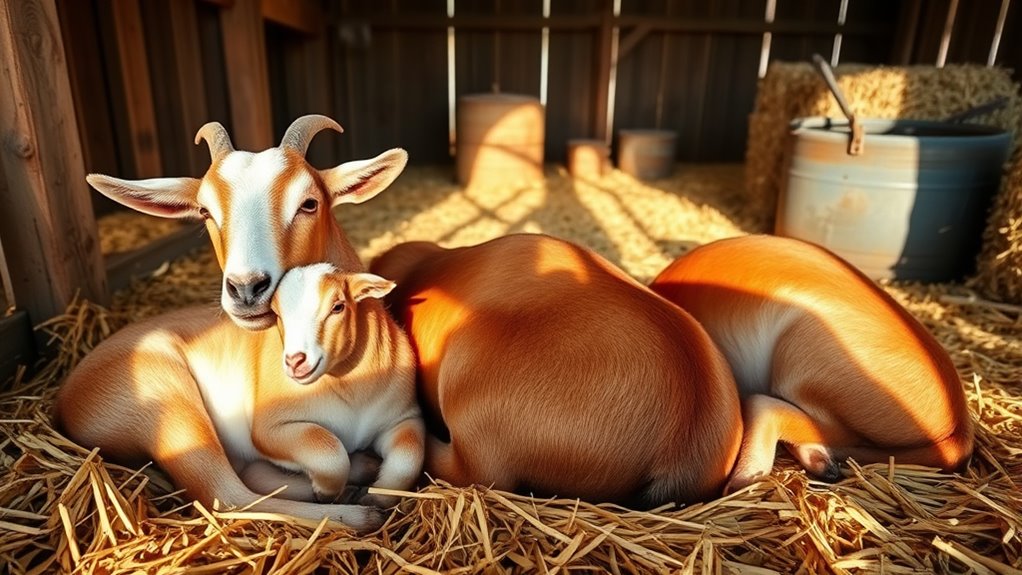
Ensuring the health of your newborn kids sets the stage for the challenges that may arise during your does' pregnancy. Nutritional challenges, like pregnancy toxemia and ketosis, often occur due to increased energy demands, especially in dairy goats carrying multiple fetuses.
The health of newborn kids is crucial for managing the challenges of pregnancy in does, particularly in dairy goats.
Physical complications such as dystocia can arise from oversized kids or poor positioning, leading to prolonged labor. You should also be aware of health issues like acidosis and enterotoxemia, which can result from dietary changes or stress.
Behavioral changes, including restlessness and refusal to eat, signal that labor is approaching. Additionally, environmental factors like disturbances can complicate delivery.
Regular monitoring and veterinary consultation are vital for effectively managing these challenges and ensuring a smooth pregnancy.
Long-term Care for Pregnant Goats
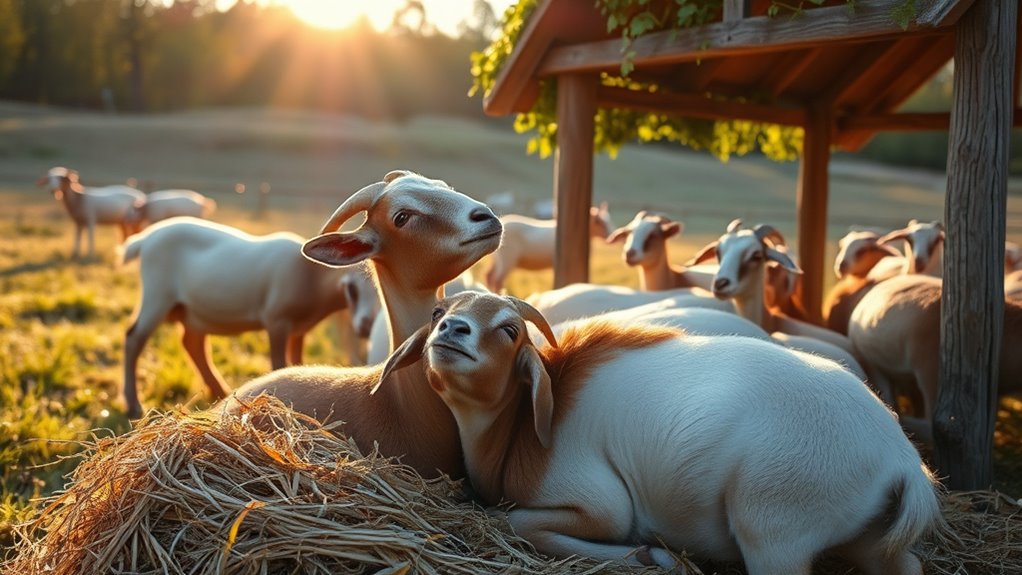
When caring for pregnant goats, you must prioritize their long-term health and well-being throughout the gestation period. Start by providing high-quality hay and free-choice mineral supplements to prevent deficiencies. Alfalfa is particularly beneficial in late pregnancy to meet increased nutritional needs.
Introduce grain about a month before kidding to support energy and milk production. Regular veterinary check-ups are crucial, along with vaccination boosters and parasite control. Ensure your goats have adequate shelter, space, and a clean environment to thrive.
Regular hoof trimming and grooming help maintain comfort and health. Finally, prepare a safe kidding area and monitor for signs of labor to ensure a smooth birthing process and proper post-kidding care for both the doe and her kids.
Frequently Asked Questions
How Long Is the Typical Gestation Period for Goats?
The typical gestation period for goats lasts between 145 to 155 days, with an average of about 150 days.
You can break this down into three trimesters, each around 50 days long.
Keep in mind that various factors, like breed size and the individual characteristics of your goats, can affect this duration.
If you're planning for kidding, it's helpful to use a gestation calculator to estimate the due date accurately.
Can Goats Experience False Pregnancies?
Absolutely, goats can experience false pregnancies, much like a mirage that leads you to believe there's something real ahead.
This condition, known as pseudopregnancy, occurs when fluid accumulates in the uterus without a viable fetus.
You'll notice signs like abdominal distention and udder enlargement, but there won't be any fetal movement.
If you suspect this, it's best to consult a veterinarian for accurate diagnosis and treatment options.
What Are Common Health Issues During Goat Pregnancy?
During goat pregnancy, you might encounter several common health issues.
Pregnancy toxemia often arises from inadequate energy intake, especially if your doe is carrying multiple fetuses.
Ketosis can occur in early lactation due to fat metabolism issues.
Be aware of urinary calculi, enterotoxemia, and CAE, which can affect your goat's overall health.
Monitoring their condition closely and providing proper nutrition will help mitigate these risks and ensure a healthier pregnancy.
How Can I Tell if My Doe Is in Distress?
If you think your doe's distress is as clear as day, you might be overlooking some signs.
Look for refusal to eat, social withdrawal, and restlessness.
Watch for any abnormal vocalizations or physical changes like swelling.
If she's straining without progress or shows signs of fatigue, that's a red flag.
Keep a close watch, and don't hesitate to consult a vet if you notice anything concerning!
Should I Separate Pregnant Goats From the Herd?
You should consider separating pregnant goats from the herd to ensure their safety and reduce stress.
This allows for better monitoring during labor and helps prevent misnursing. While natural behavior suggests some does may prefer staying with the herd, a controlled environment can lead to healthier outcomes for both the doe and her kids.
Ultimately, weigh the benefits of separation against the needs of your herd to make the best decision.
Conclusion
In caring for pregnant goats, remember that "an ounce of prevention is worth a pound of cure." By recognizing signs of pregnancy and providing proper care, you can ensure a healthy doe and thriving kids. Stay proactive in your approach, from pre-breeding preparations to post-kidding support. With your attention and dedication, you'll set the stage for a successful kidding season, leading to happy, healthy goats that thrive under your watchful eye.

